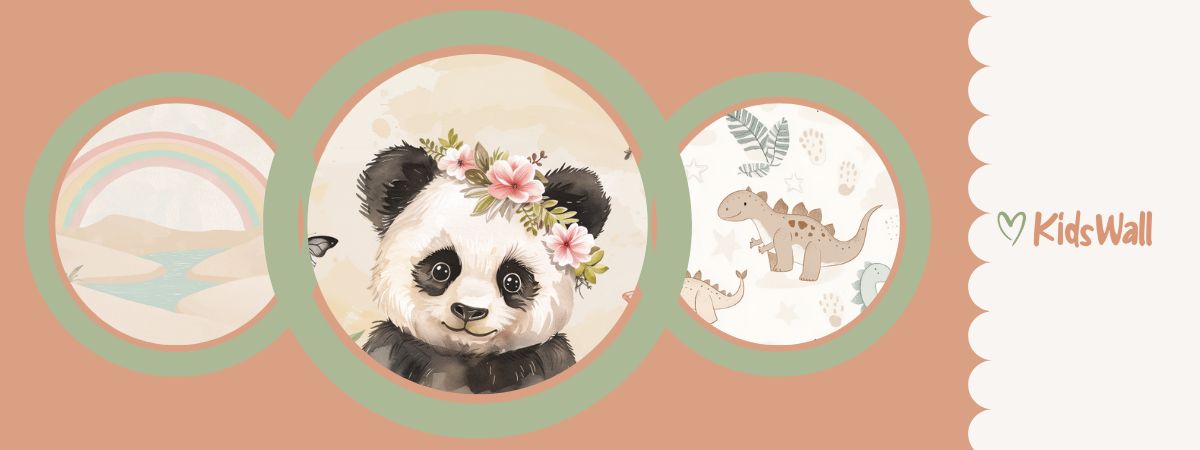
Our tips for hanging your wallpaper without bubbles
Putting wallpaper in your children's room is a wonderful way to bring color and fantasy to their universe. Whether it's jungle patterns, savanna animals, unicorns, or hot air balloons, the choice is vast and each design can stimulate the imagination of the little ones. However, it is crucial to know how to correctly apply the wallpaper to avoid unpleasant air bubbles that can spoil the final aesthetic.
In this article, you will discover essential tips for hanging your wallpaper without fear while creating a harmonious space for your little adventurers. Let's go together to understand the most effective hanging techniques and the mistakes to avoid!
How to prepare before hanging the wallpaper?
Choosing the right wallpaper for the children's room
The choice of patterns is crucial. To stimulate the imagination, opt for captivating designs. For example, the dense jungle with its lush trees and exotic animals for a wild atmosphere. Or, be seduced by the elegant unicorns galloping through colorful clouds. Hot air balloons, on the other hand, offer an airy and poetic atmosphere.
Patterns are not the only criteria; also consider the texture of the wallpaper. Some papers are specially designed to be easily cleaned, which is ideal for children's rooms often subject to artistic mishaps.
Wall preparation: a key step
To ensure perfect adhesion of the wallpaper, it is essential to start with meticulous wall preparation. Make sure the surface is completely flat and clean. Remove all residues of glue or previous wallpaper with a suitable product.
The surface must be smooth to avoid any imperfections. Fill in any holes or cracks with a suitable filler. After drying, lightly sand to achieve a smooth finish. This step ensures an ideal base for your favorite wallpaper.
What tools are essential for hanging wallpaper?
Then take an inventory of the necessary wallpapering tools. Proper use of each tool makes all the difference:
- Smoothing roller: essential for smoothing the wallpaper and eliminating air bubbles.
- Soft brush: ensures delicate application without damaging the pattern.
- Putty knife: useful for precision when cutting at the corners of the walls.
- Homogeneous glue: a wise choice to guarantee perfect adhesion.
What techniques to use to hang wallpaper without bubbles?
Application of glue: a determining factor
The application of glue on the paper must be uniform, but not excessive. Apply it with a paint roller or a dedicated brush. Make sure to spread it evenly over the entire surface.
Let the glue rest for a few minutes so that it penetrates the paper slightly. This facilitates adhesion to the wall and greatly reduces the risk of annoying air bubbles. Don't forget to follow the specific instructions for the chosen wallpaper to optimize the result.
Hanging technique and connecting the seams
Start by hanging the strip of paper at the top of the wall. With the help of a level, make sure it is straight. This initial precision avoids unsightly misalignments lower down.
When handling the paper, use the soft brush to gently smooth it. Then use the smoothing roller from the center to the edges to remove any possible air bubbles.
Care and impeccable finishes
When cutting the excess, keep a firm hand on the putty knife against the edge of the wallpaper. Cut at a right angle to ensure a neat finish.
Knowing that each pattern brings its own set of particular challenges - pay attention to continuous patterns like savanna animals requiring special attention to the seams to maintain a coherent image without visual interruption between strips.
Common mistakes and how to avoid them?
As with any DIY project, some pitfalls can compromise your success. Here are three common mistakes:
- Skipping wall preparation can result in bubbles and poor adhesion.
- Using unsuitable glue increases the risk of premature peeling.
- Neglecting the rest time after applying the glue diminishes absorption and creates smudges.
Fixing minor imperfections
Despite all precautions, bubbles can still appear. The solution? Use a sterilized pin to gently pierce the bubble and then gently roll the smoothing roller over it. This helps the air to escape without damaging the pattern.
If you notice a slight misalignment of patterns, moisten that area and gently pull to realign the edges carefully.
FAQs on hanging wallpaper without bubbles
What type of glue to use for wallpaper?
Use a specific homogeneous glue adapted to the type of wallpaper chosen. A special vinyl glue is recommended for textured or heavy papers, while standard glue is sufficient for light papers. Always follow the manufacturer's recommendations for best results.
Can you hang wallpaper yourself in a children's room?
Yes, with proper preparation and suitable tools, hanging wallpaper yourself is entirely feasible even for novices. Choosing a simple pattern and understanding the hanging techniques ensure a professional result even without prior expertise.
Why is it important to prepare the walls?
Preparing the walls ensures a flat and clean surface, essential to guarantee optimal adhesion. This step prevents the appearance of air bubbles and ensures a long lifespan for the wall covering. Remember to remove residues, fill in cracks, and sand before each application.
What is the method for successful complex pattern matching?
For complex patterns, carefully analyze each cut strip before hanging. Identify the points where the pattern repeats and adjust accordingly. A slight overlap when adjusting can help to conceal visible transitions on irregular surfaces. Take your time to ensure a flawless match.




